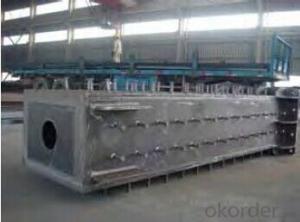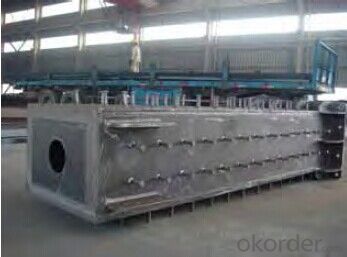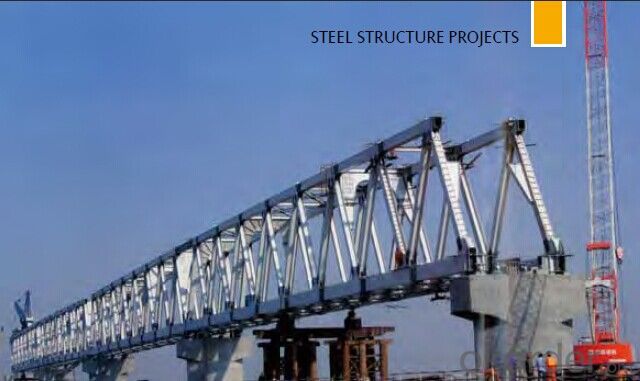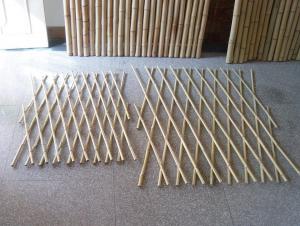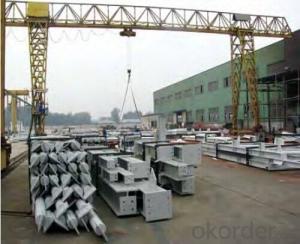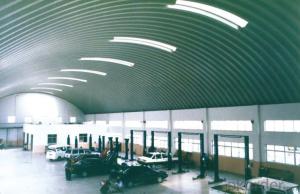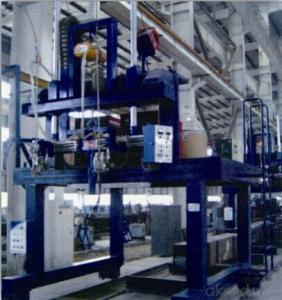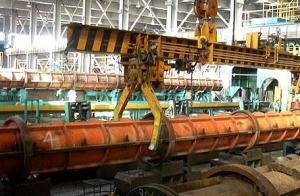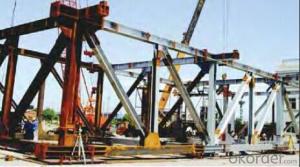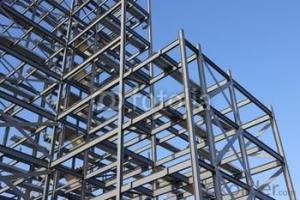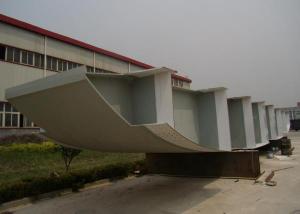High Class Steel-Work made in China
- Loading Port:
- China Main Port
- Payment Terms:
- TT OR LC
- Min Order Qty:
- -
- Supply Capability:
- -
OKorder Service Pledge
OKorder Financial Service
You Might Also Like
Steel Structure
Description:
1.Length of the welding withnot indication, full welding should be applied
2.Seam without indication is fillet weld, height is 0.75t
3.The cutting angle without indication, radius R=30
4.Cutting angle not specified should be
5.The diameter of the hole for the bolt if not specified, D=22
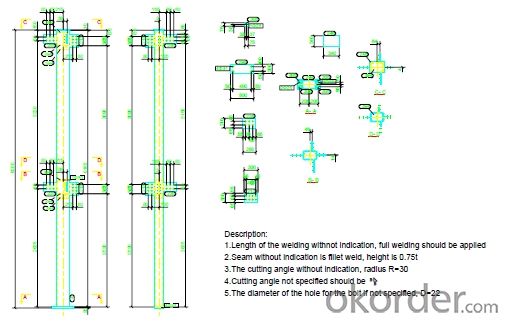
Project Reference:
Area: 17,000m2
Steel Structure Quantity: 2,700ton
Color-Steel Plate Area: 29,670ton
Column Height: 32m
Weight of Per Column: 25ton
Crane Tonnage: 300ton
Total Cost: 25,080,000RMB
Duration: 150days

- Q: How are steel structures designed to accommodate green roofs or vegetated systems?
- Steel structures can be designed to accommodate green roofs or vegetated systems by incorporating specific features such as additional load-bearing capacity, proper drainage systems, and adequate support for vegetation. The design may involve reinforcing the steel structure to handle the weight of the green roof, installing waterproof membranes to prevent leakage, and incorporating irrigation and drainage systems to ensure proper water management. Additionally, the design may include provisions for anchoring and support structures to secure the vegetation and prevent it from being dislodged during strong winds or storms. Overall, the design of steel structures takes into consideration the unique requirements of green roofs or vegetated systems to ensure their successful integration.
- Q: What are the different types of steel coatings used in construction?
- There are several types of steel coatings used in construction, including galvanized steel coatings, epoxy coatings, polyurethane coatings, and powder coatings. Each type of coating offers unique benefits and is chosen based on factors such as corrosion resistance, durability, and aesthetic appeal.
- Q: What are the common challenges in the fabrication and erection of steel structures?
- Some common challenges in the fabrication and erection of steel structures include accurate measurement and alignment, managing heavy loads and equipment, ensuring proper welding and connections, dealing with complex architectural designs, coordinating with different trades and subcontractors, and adhering to strict safety regulations. Additionally, factors such as weather conditions, site accessibility, and project timelines can also pose challenges during the construction process.
- Q: How are steel structures designed for blast-induced vibrations?
- Steel structures are designed for blast-induced vibrations by considering the dynamic response of the structure to the blast load. This involves analyzing the blast loading characteristics, such as the magnitude, duration, and frequency content, and then designing the structure to withstand these loads. Various design techniques, such as dynamic analysis, material selection, and structural detailing, are employed to ensure the steel structure can effectively absorb and dissipate the energy generated by the blast, thus minimizing the impact of vibrations on the structure and its occupants.
- Q: What are the applications of steel structures in industrial buildings?
- Steel structures have numerous applications in industrial buildings due to their exceptional strength, durability, and versatility. Some key applications include the construction of warehouses, factories, power plants, and distribution centers. Steel structures provide a cost-effective solution for large clear-span spaces, allowing for flexible floor plans and efficient utilization of space. Additionally, steel's high load-bearing capacity makes it ideal for supporting heavy machinery and equipment. The inherent fire-resistant properties of steel enhance safety in industrial settings. Overall, steel structures offer a reliable and efficient solution for constructing robust and functional industrial buildings.
- Q: What are the design considerations for steel residential complexes?
- When designing steel residential complexes, there are several important considerations that need to be taken into account. These considerations include structural integrity, fire safety, energy efficiency, aesthetics, and sustainability. Structural integrity is crucial in steel residential complexes as it ensures the safety and stability of the building. Steel has high strength-to-weight ratio, making it an ideal material for constructing tall and large buildings. The design should incorporate appropriate load-bearing systems, such as steel frames or reinforced concrete cores, to withstand various loads and natural disasters. Fire safety is another crucial consideration for steel residential complexes. Steel is a non-combustible material, but it can lose its strength under high temperatures. Therefore, fire-resistant measures should be implemented, such as fire-rated coatings or fireproof insulation, to protect the steel structure and prevent the spread of fire. Energy efficiency is an important aspect of modern building design. Steel residential complexes can incorporate energy-saving features like insulation, energy-efficient windows, and efficient HVAC systems to reduce energy consumption. The design should also consider the orientation of the building to maximize natural lighting and minimize heat gain or loss. Aesthetics play a significant role in residential complexes as they contribute to the overall appeal and livability of the building. Steel structures can offer design flexibility and creative possibilities, allowing architects to create unique and visually appealing designs. The exterior finishes, interior layouts, and landscaping should be carefully considered to create a harmonious and visually pleasing environment. Sustainability is becoming increasingly important in building design. Steel is a highly recyclable material, and using it in construction reduces the demand for new resources. The design can incorporate sustainable features like rainwater harvesting systems, green roofs, and energy-efficient appliances to minimize environmental impact. Additionally, the use of sustainable construction practices and materials can contribute to obtaining green building certifications. In conclusion, when designing steel residential complexes, structural integrity, fire safety, energy efficiency, aesthetics, and sustainability are crucial considerations. By addressing these factors, architects and engineers can create safe, visually appealing, and environmentally friendly residential complexes.
- Q: How are steel structures designed for pharmaceutical manufacturing facilities?
- Steel structures for pharmaceutical manufacturing facilities are designed with a focus on ensuring cleanliness, durability, and flexibility. Design considerations include designing the structure to meet specific regulatory requirements, such as Good Manufacturing Practices (GMP), which dictate strict cleanliness and hygiene standards. Steel structures are also designed to withstand the loads and stresses associated with pharmaceutical equipment and processes. Additionally, flexibility is incorporated into the design to allow for future modifications and expansions as the facility's needs evolve.
- Q: What are the design considerations for steel theme hotels?
- Some of the design considerations for steel theme hotels include incorporating steel elements in the architecture and interior design to create a modern and industrial aesthetic. The use of steel can also provide structural strength and durability to the building. Additionally, the design should focus on creating a cohesive and immersive theme that complements the steel elements, such as using metallic colors and textures throughout the hotel. Furthermore, incorporating innovative and sustainable features in the design can enhance the overall guest experience and align with the theme of steel.
- Q: How are steel structures designed for commercial buildings?
- Steel structures for commercial buildings are designed through a systematic process that involves analyzing the building's requirements, determining the loads it will bear, and selecting appropriate steel sections. Engineers use advanced software to create 3D models, conduct structural analysis, and optimize the design. The design considers factors such as column spacing, beam sizes, and connections to ensure structural stability, safety, and cost-effectiveness. Steel structures offer flexibility, durability, and ease of construction, making them a popular choice for commercial buildings.
- Q: How are steel structures used in oil and gas refineries?
- Steel structures are extensively used in oil and gas refineries due to their durability, strength, and resistance to corrosion. These structures are employed in various applications such as supporting heavy equipment, providing elevated platforms for workers, and constructing storage tanks and pipelines. The use of steel ensures the safety and longevity of the refinery infrastructure, allowing for efficient and reliable operations in the oil and gas industry.
Send your message to us
High Class Steel-Work made in China
- Loading Port:
- China Main Port
- Payment Terms:
- TT OR LC
- Min Order Qty:
- -
- Supply Capability:
- -
OKorder Service Pledge
OKorder Financial Service
Similar products
Hot products
Hot Searches
